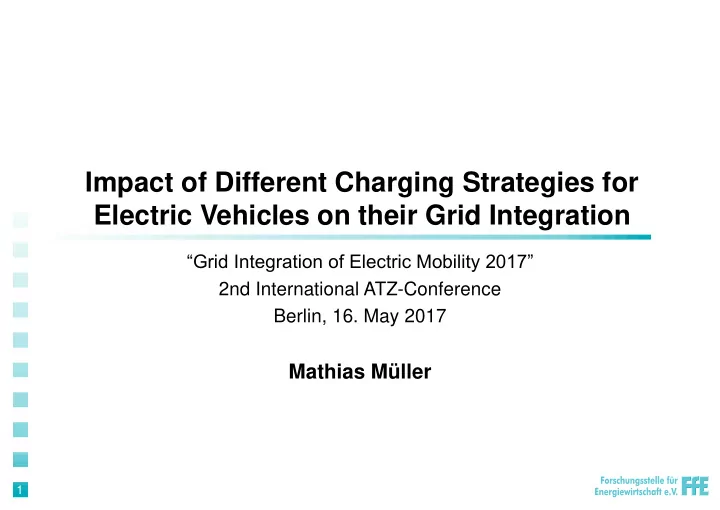

Impact of Different Charging Strategies for Electric Vehicles on their Grid Integration “Grid Integration of Electric Mobility 2017” 2nd International ATZ-Conference Berlin, 16. May 2017 Mathias Müller 1
Is Controlled Charging of Electric Vehicles Blessing or Curse for their Grid Integration??? 2
Merit Order Netzausbau (MONA) 2030 3
The Project MONA 2030 – Partners and Team www.ffe.de/mona 16 companies support MONA 2030… Merit-Order Netzausbau 2030 … and enable therefore 15 man -years of research on the grid. 4
Approach – General set-up of the project www.ffe.de/mona Grid Topologies Load profiles Type Grid SIMULATION Cost-benefit analysis Merit Order Grid optimizing measures Scenarios 5
GridSim – The FfE Distribution Network Simulation Tool www.ffe.de/mona Combined load flow calculation and energy system model for distribution grids Reference Variables • Voltage • Power Heat demand in MWh/a • Price Mobility demand in MWh/a Electricity demand in MWh/a 6
GridSim – FfE Distribution Network Simulation Tool www.ffe.de/mona Combined load flow calculation and energy system model for distribution grids Components: rONT H ousehold Loads (3-phases) PV-Plants Reference Variables: Electrical Storage System • voltage Power-to-Heat Plants • power Electric Vehicles • costs LVR Reactive Power Management Adjustable Transformer Line Voltage Regulator 7
Charging Control Strategies 8
Division of the EV Battery within three fundamental Sectors www.ffe.de/mona SoC min SoC Departure 0% 100% A C B A B C A: SoC < SoC min Maximum charging power (independent of charging control strategy) Charging Power depends on charging control strategy B: SoC min < SoC < If SoC Departure will not be reached until departure: maximum charging SoC Departure power C: SoC Departure < SoC Charging Power depends on charging control strategy 9
Uncontrolled Charging www.ffe.de/mona SoC min SoC Departure 0% 100% A C B Start of Charge: As soon as the EV is connected Charge Power: Maximum charging power regardless of the current SoC 10
Own Consumption Optimized Control www.ffe.de/mona SoC min SoC Departure 0% 100% A C B A B C A: SoC < SoC min Maximum charging power (independent of charging control strategy) Charging with PV surplus B: SoC min < SoC < If SoC Departure will not be reached: Charging with maximum power before SoC Departure departure to reach SoC Departure . C: SoC Departure < SoC Charging only with PV surplus 11
Price Oriented Control www.ffe.de/mona SoC min SoC Departure 0% 100% A C B A B C A: SoC < SoC min Maximum charging power (independent of charging control strategy) Charging during the cheapest times to reach SoC Departure B: SoC min < SoC < (perfect price forecast) SoC Departure Charging if Price < 0,7 * Ø Price per Day C: SoC Departure < SoC (If the price is 30 % lower than the average of that day) 12
Voltage Guided Control www.ffe.de/mona Charging Power: maximum charging power (P max ) U household > U critical, decrease Charging Power: controlled in a linear way between P max and P min U min < U household < dependent of voltage level U critical, decrease Charging Power: no charging U min > U household 13
Impact of different Charging Control Strategies 14
Simulation Scenario www.ffe.de/mona Type Grid 4 • 45 buildings / househoulds • 26 PV-Plants • 10 Heat Pumps • 23 Electric Vehicles • 7 BEV (47 kWh battery) • 16 PHEV (19 kWh battery) • Charging Stations: • 12 x 11 kW (3-phases) • 11 x 3,3 kW (1-phase) • SoC min 12 % (~ 30 km (BEV)) • SoC Departure 70 % (~180 km)) 15
Maximum Charging Concurrency (Uncontrolled Charging) www.ffe.de/mona 16
17 Comparison Maximum Charging Concurrency Own Consumption Uncontrolled www.ffe.de/mona Price Oriented Voltage Guided
Power Duration Curve of the Transformer www.ffe.de/mona Peak Load of price oriented control 2-3 x higher 18
Power Duration Curve of the Transformer www.ffe.de/mona Peak Load of price oriented control 2-3 x higher 19
Voltage Reserve Duration Curve www.ffe.de/mona The voltage reserve duration curve describes the minimum distance to the allowed voltage band boarders for each timestep in the whole grid area. 20
Voltage Reserve www.ffe.de/mona Influence of the maximum charging power of the wallboxes on the Voltage Reserve Charging Power: 3.3 / 11 kW Charging Power: 3.3 / 22 kW 21
Voltage Reserve www.ffe.de/mona Influence of the maximum charging power of the wallboxes on the Voltage Reserve Charging Power: 3.3 / 11 kW Charging Power: 3.3 / 22 kW 22
Conclusion www.ffe.de/mona 1 Controlled Charging can be blessing or curse! 2 The price oriented charging strategy leads to the highest charging concurrencies • Price oriented charging strategy: 94 % • Own consumption optimized control: 45 % • Uncontrolled Charging: 30 % 3 The price oriented charging strategy increases the peakload of the grid by more than 120 % 4 The best control strategy in respect to the system voltage is the own consumption optimized control 23
Discussion? Questions? www.ffe.de/mona ? Storage ! Questions? 24
Thank you for your attention! www.ffe.de/mona Mathias Müller Florian Samweber Peter Leidl +49 (89) 158121-32 MMueller@ffe.de Forschungsstelle für Energiewirtschaft e.V. Am Blütenanger 71 80995 Munich Germany www.ffe.de 25
Recommend
More recommend